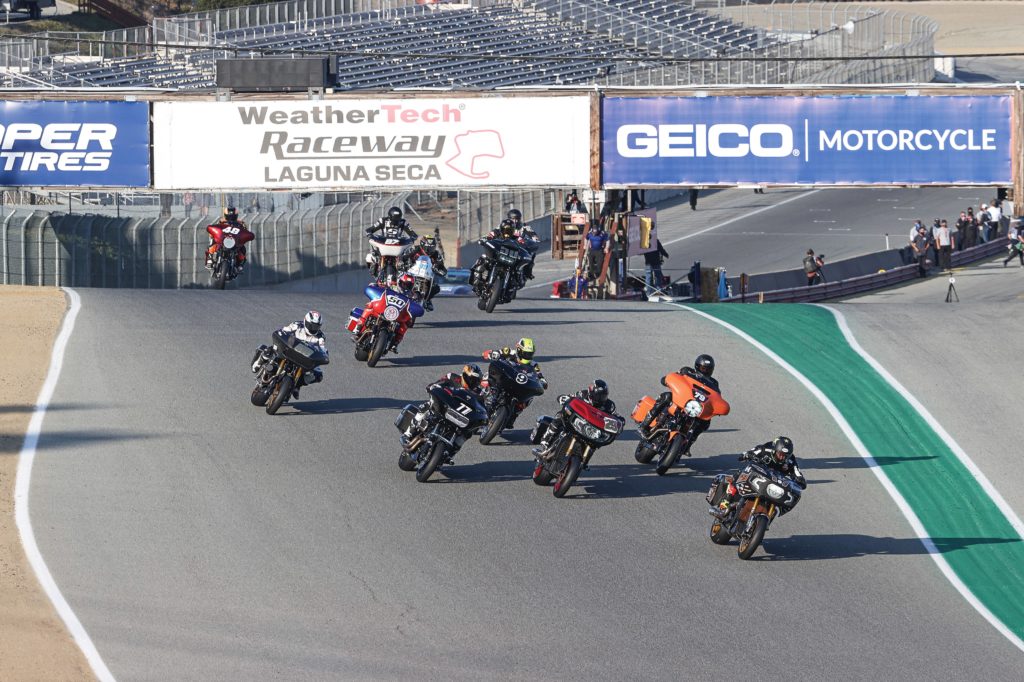
An in-depth look at the motorcycles and teams in what was perhaps American roadracing’s wildest spectacle ever
Words by Thunder Press staff Photos by Brian J. Nelson and KOTB Teams
The term ‘insanity’ is cliché and often overused in today’s lexicon. But in the case of the Drag Specialties King of the Baggers event, which culminated in a wild and wacky on-track competition at Laguna Seca – watched by millions – that involved a dozen Harley- and Indian-powered touring motorcycles ridden by some of the best racers in the country, it’s entirely apropos.
If you’ve seen the telecast, you know what we’re talking about. If you haven’t, you owe it to yourself to check it out on YouTube. Words don’t do it justice.
We reported on the race briefly in our November issue, but wanted to dive much deeper into the bikes and the teams and the seriously disturbed thinking it took to actually participate in this extravaganza. So we contacted each of the teams to get the skinny. Most got back to us with their stories, and while a couple didn’t, the grist we ended up with on the motivational and technical sides of the KOTB story more than made up for it.
So until next season, when it’s rumored Drag Specialties and MotoAmerica will turn the insanity knob to eleven with a 5-race KOTB series at places like Laguna, Barber and maybe even Indianapolis, enjoy the coverage!
Da Winna! The Indian that challenged a fleet of Harleys — and won!

Words by Kali Kotoski Photos by Brian J. Nelson and S&S Cycles
Piloting a lean and agile Indian Challenger, Tyler O’Hara and Team S&S Cycles knew the King of the Baggers race would be huge in every conceivable way. So they jumped in with both cylinders blasting and claimed a resounding victory at Laguna Seca, upsetting 11 teams running race-worthy Harley-Davidsons, with a Vance & Hines Harley grabbing runner-up honors and a Roland Sands-prepped Indian Challenger netting third.
O’Hara, who found himself at one point losing the lead to Hayden Gillim (on the V&H Harley) when he lost the front in treacherous turn two, skidded into the sand trap but kept the bike upright, regained his composure and clawed his way to victory in stunning fashion.
“Pure instinct kicked in,” O’Hara told Thunder Press. “I said to myself, ‘don’t crash right now because that thing is heavy.’ I knew I was going to win the race…I just didn’t know how.”
Immediately following the race, the internet exploded with theories about how a Challenger with a 108 cubic-inch PowerPlus engine could have spanked Harleys with 131 cubic-inch crate engines and some with turbos.

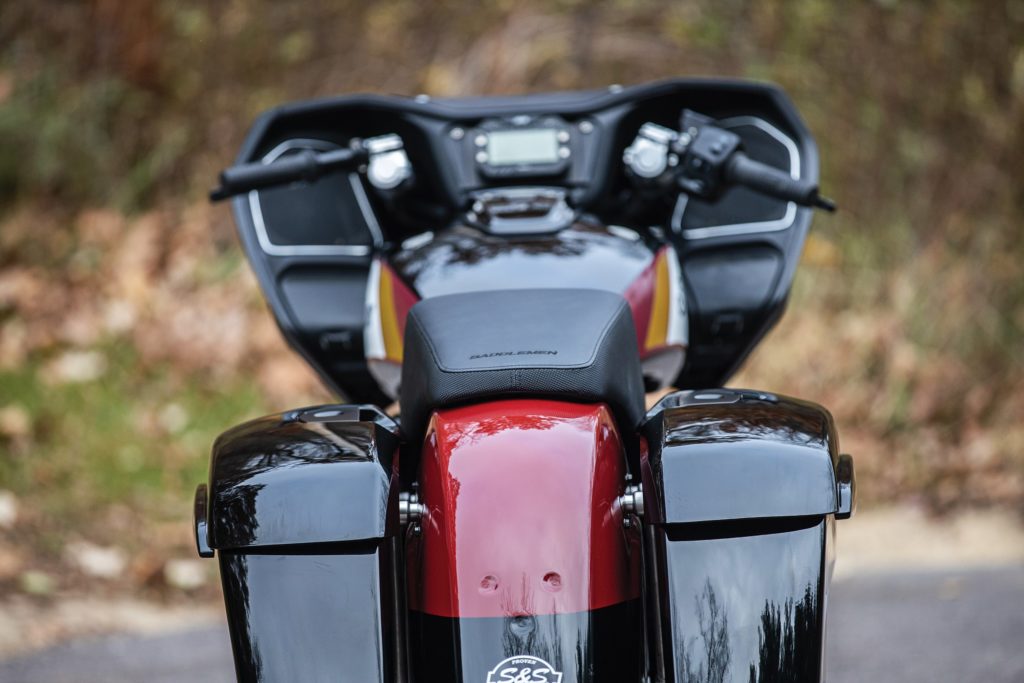
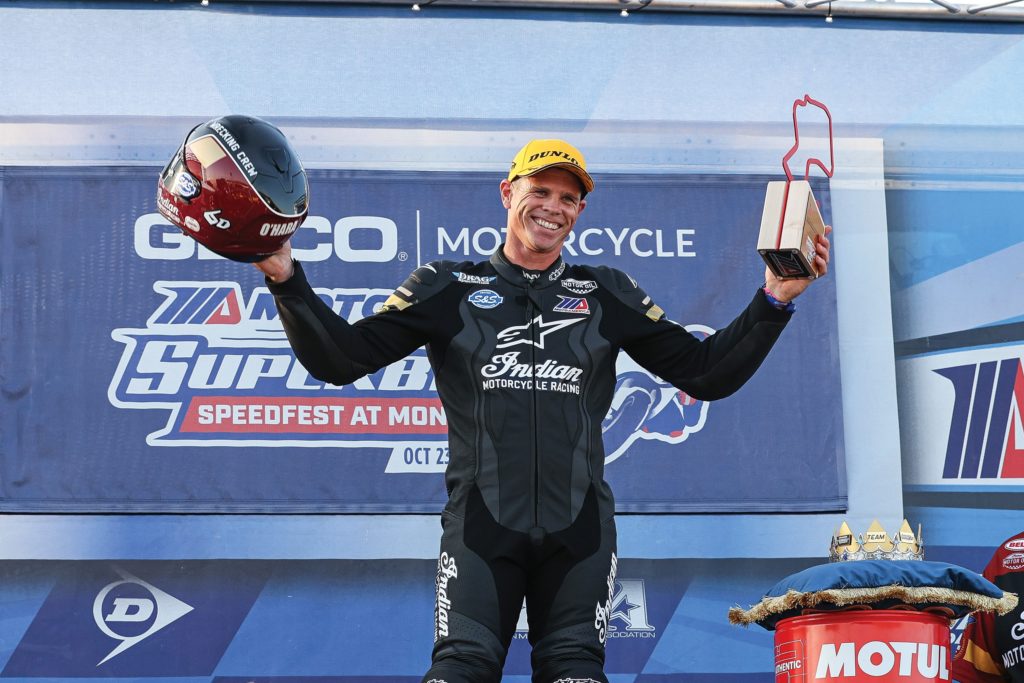
“The coolest by-product of the race is that we had people doing tons of guesswork on our Facebook page,” S&S Cycles’ VP of Marketing David Zemla said. “Eventually, we had to do a tech report that pulled up our skirt so people could see everything we did.”
According to Zemla, internet critics and skeptics were vehemently claiming that S&S had done a major engine overhaul, despite the rules clearly restricting the Challenger to its stock 108 cubic-inch size. By exposing themselves, it was clear that power alone wasn’t the defining factor in the win – which most roadrace-savvy onlookers knew all along.
“We went into this knowing it would not be a horsepower race,” Zemla said. “This was going to be a chassis race. [Still], we tore out the motor and did a ton of dyno tests and realized the engine made really good power, but we realized it needed to be further up in the RPM range instead of the grunty, up-front torque.”
Besides installing bigger camshafts and doing some CNC porting on the heads to increase airflow while switching the belt final drive to a chain to fine-tune gearing for higher revs, S&S admittedly kept the engine relatively stock and focused more on suspension and chassis.

The S&S folks machined their own triple trees, which allowed them to adjust rake and trail while also grafting on a fork assembly from Indian’s sporty FTR1200.
“That really tightened up the front end,” Zemla told us, “and the bike went from a cruiser stance to a stance that would get us around turns. That was a pretty huge move.”
The company also re-valved and extended the Fox factory shocks to bring the rear end up, designed an exhaust that provided greater cornering clearance without sacrificing power, hand made a fuel cell to limit sloshing, installed a lightweight lithium-powered Full Spectrum battery, beefed up a Saddlemen saddle, shaved weight by making everything carbon fiber (besides the faring) thanks to AirTech, threw on a K&N air filter and used a Klock Werks Kliphanger handlebar to preserve a factory look while giving the rider the ability to make adjustments.
In the end, S&S’s Challenger build dropped over 200 pounds from the factory setup, weighing in at a semi-svelte 599 lbs.

“Trying to get this bike as light as possible was a challenge we faced around every corner because these touring bikes don’t want to be lighter,” Zemla said.
Prior to the race and confident with the build, the team headed down south from their Wisconsin facility and flew O’Hara out from California. What was expected to be a day of dialing in the chassis and adjusting the ergos for O’Hara turned out to be a complete wash, as it rained the whole day.
“The one thing I realized is that gas in the tank was sloshing around a lot during deceleration,” O’Hara said, “enough so that I could feel it.” It led S&S to make a hand-built aluminum fuel cell, which also freed up more space for airflow.
Luckily, S&S secured a day of practice on a private track in northern Minnesota before heading to the showdown at Laguna.
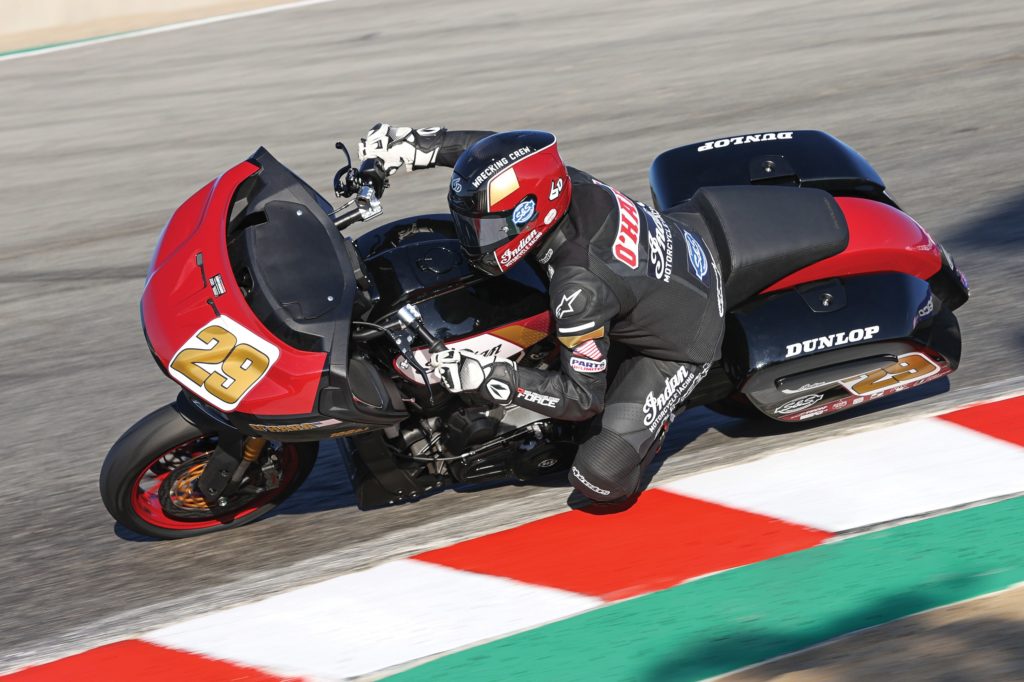
“Our primary takeaway was that O’Hara has the ability to take the bike into a corner so much harder than we imagined. He got it right out of the gate and it was spectacular,” Zemla said, adding that minor adjustments to the suspension shaved second after second off of the lap time.
Still, heading into the race the team was filled with trepidation.
“We knew we were absolutely down on power, way down on power,” Zemla said. “We knew the track and were worried that a couple of the straightaways would work against us.”
O’Hara shared similar concerns, worried that the race could come out to be just a point-and-shoot showdown, but he had faith in the build.
“Plain and simple, the bike is a modern American V-twin bagger with the tech a modern superbike would have. The transmission was tight and the bike accelerated well,” O’Hara said.
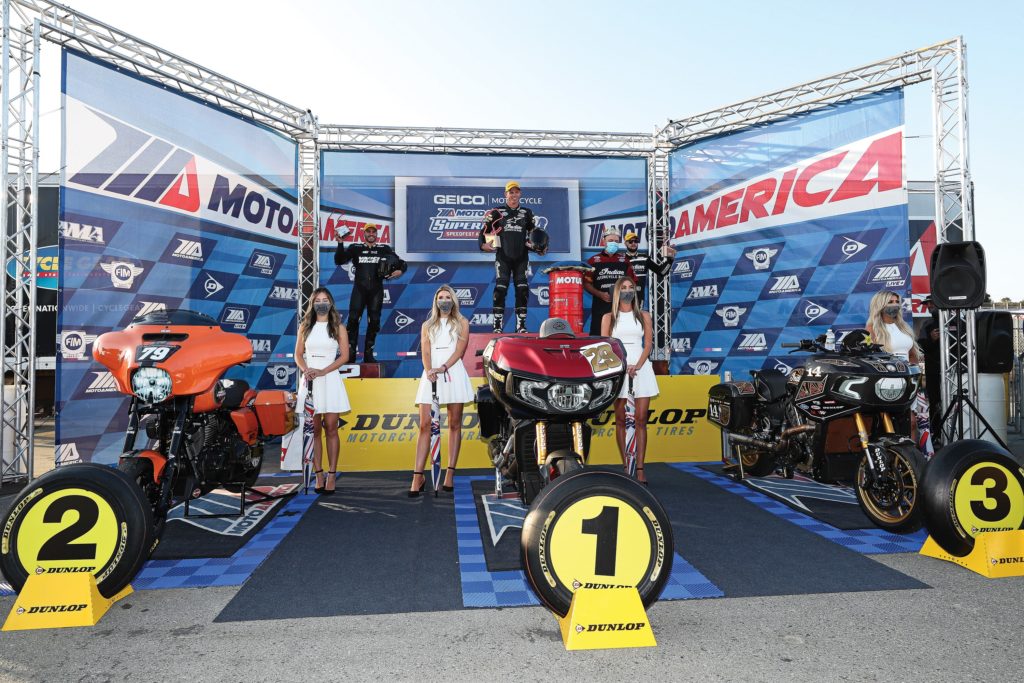
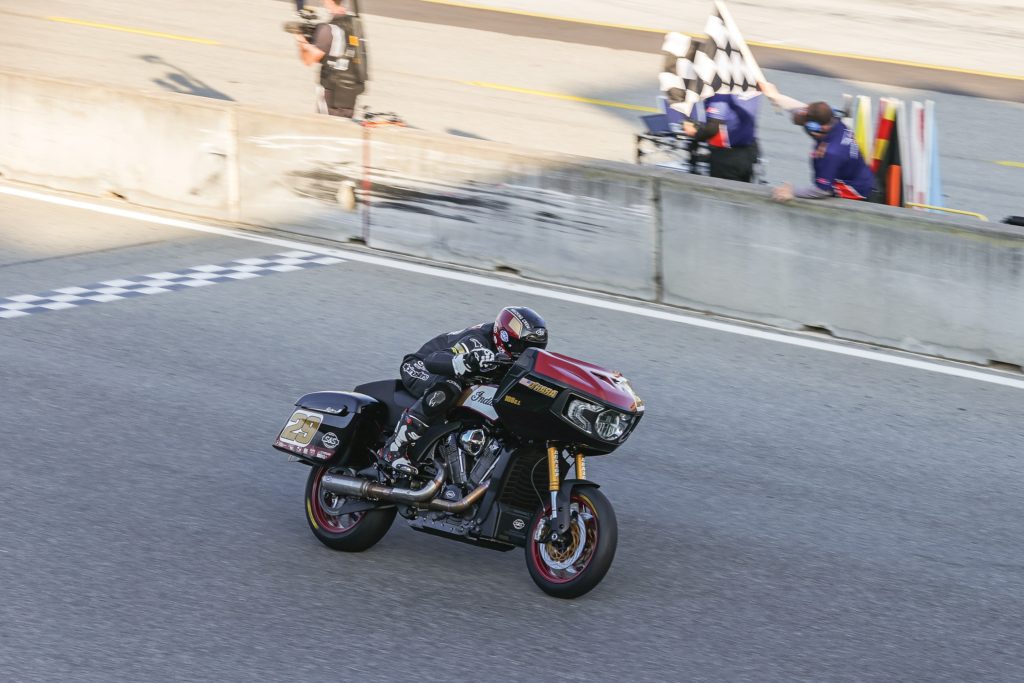

At the end of the day, O’Hara posted his best lap time at only 13 seconds longer than the best time in the superbike category, astounding V-Twin fans and blowing people’s minds while proving that the insanity of a bagger race had unleashed a new viable race category that would push teams to the limit and continue to raise the performance standards for aftermarket companies—something that O’Hara said will undoubtedly trickle down to the consumer.
“Everybody is going nuts and wants to see more racing,” O’Hara said, “and I think the payoff for the industry will be great.”
For Zemla, taking the wild idea of pitting baggers against each other on a legendary track yielded the expected results, even if haters had reservations.
“The culture of motorcycle aftermarket companies is brutally competitive,” he said. “Everybody thought, at first, it would be this fun and cool thing, with key aftermarket guys having a chance to show off performance baggers. And in typical fashion, it escalated very quickly. No one was surprised. We love this kind of stuff.”
Follow Thunder Press’ in-depth coverage of the King of the Baggers race throughout December!

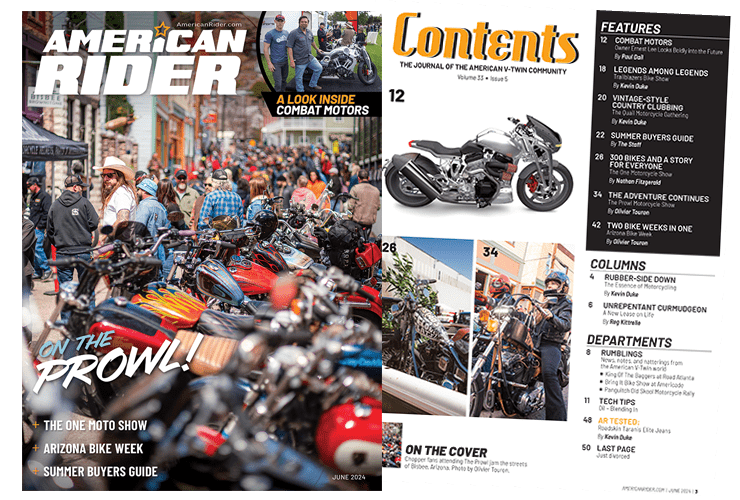

















[…] out Thunder Press’ coverage of the race Here and Here and […]